

chloe
Die Hoffnung II 1907 Painting by Gustav Klimt with Oil Gold Platinum on Canvas. Gustav Klimt - The complete works. Pop Art. Postwar Context In the years following World War II, America enjoyed an unprecedented period of economic and political growth.
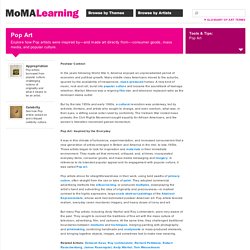
Andy Warhol. Andy Warhol (/ˈwɔrhɒl/;[1] August 6, 1928 – February 22, 1987) was an American artist who was a leading figure in the visual art movement known as pop art.
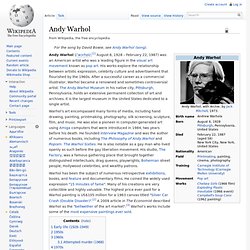
His works explore the relationship between artistic expression, celebrity culture and advertisement that flourished by the 1960s. After a successful career as a commercial illustrator, Warhol became a renowned and sometimes controversial artist. The Andy Warhol Museum in his native city, Pittsburgh, Pennsylvania, holds an extensive permanent collection of art and archives. It is the largest museum in the United States dedicated to a single artist. Campbells Soup Cans, 1962. Moonwalk, 1987. Jasper Johns. "I think a painting should include more experience than simply intended statement.
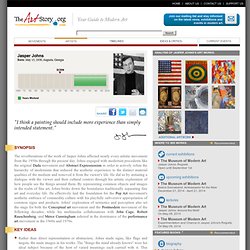
" The reverberations of the work of Jasper Johns affected nearly every artistic movement from the 1950s through the present day. Johns engaged with modernist precedents like the original Dada movement and Abstract Expressionism in order to actively refute the hierarchy of modernism that reduced the aesthetic experience to the distinct material qualities of the medium and removed it from the viewer's life. He did so by initiating a dialogue with the viewer and their cultural context through his artistic exploration of how people see the things around them.
By representing common objects and images in the realm of fine art, Johns broke down the boundaries traditionally separating fine art and everyday life. He effectively laid the foundation for the Pop Art movement's aesthetic embrace of commodity culture with his playfully subversive appropriation of common signs and products. Childhood Early Training. Numbers. Surrealism.
Surrealism originated in the late 1910s and early '20s as a literary movement that experimented with a new mode of expression called automatic writing, or automatism, which sought to release the unbridled imagination of the subconscious.

André Breton. (b Tinchebray, 19 Feb 1896; d Paris, 28 Sept 1966).

French writer. While still an adolescent he came under the influence of Paul Valéry and Gustave Moreau, who for a long period were to influence his perception of beauty. From that time on, his poetic creation interrelated with his reflections on art, which like Gide’s were conditioned by a moral code. He considered that it is not possible to write for a living, but only from interior necessity; in the same way, painting must always derive from an irrepressible need for self-expression. These criteria guided Breton both in his dealings with the Surrealist group (of which he was the uncontested leader) and in his articles on painting, collected in editions of Le Surréalisme et la peinture (first published in 1928).
Breton’s family were of modest means. Surrealism. Surrealism was an artistic, intellectual, and literary movement led by poet André Breton from 1924 through World War II. The Surrealists sought to overthrow the oppressive rules of society by demolishing its backbone of rational thought. To do so, they attempted to tap into the “superior reality” of the subconscious mind. “Completely against the tide,” said Breton, “in a violent reaction against the impoverishment and sterility of thought processes that resulted from centuries of rationalism, we turned toward the marvelous and advocated it unconditionally.” Cut-and-pasted gelatin silver prints, cut-and-pasted printed paper, pencil, and pencil frottage on paper, 19 3/4 x 13 1/4″ (50.1 x 33.6 cm). Purchase. © 2012 Artists Rights Society (ARS), New York/ADAGP, Paris267.1935. Abstract Expressionism. The Flesh Eaters, 1952 William Baziotes (American, 1912–1963) Oil and charcoal on canvas; 60 x 72 1/8 in. (152.4 x 183.2 cm) Purchase, George A.
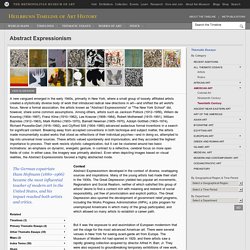
Hearn Fund, Arthur Hoppock Hearn Fund, and Hearn Funds, Bequest of Charles F. Iklé, and Gifts of Mrs. Carroll J. Post and Mrs. George S. A new vanguard emerged in the early 1940s, primarily in New York, where a small group of loosely affiliated artists created a stylistically diverse body of work that introduced radical new directions in art—and shifted the art world's focus.
Mark Rothko. Jackson Pollock. Timeline: Abstract Expressionism.
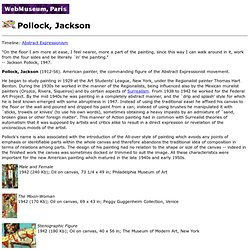
Cubism. What is Cubsim? Within the first two decades of the 20th century, a new art movement began that was unlike any other—Cubism.
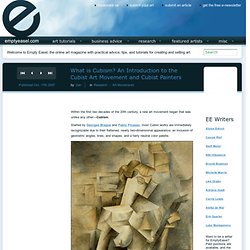
Started by Georges Braque and Pablo Picasso, most Cubist works are immediately recognizable due to their flattened, nearly two-dimensional appearance; an inclusion of geometric angles, lines, and shapes; and a fairly neutral color palette. As the movement evolved, color, texture, and graphic elements (like text) were added, to the point where later Cubist works often appeared more like collage than anything else. But Cubism wasn’t just a specific “style” or “look”—it actually allowed artists an entirely different way of seeing and depicting real-life objects.
What is Cubism? Unlike traditional still-lifes, landscapes, or portrait paintings, Cubist paintings aren’t meant to be realistic or life-like in any way. Pablo Picasso.